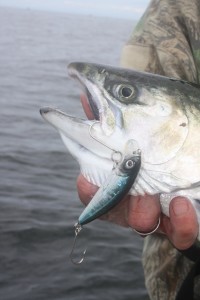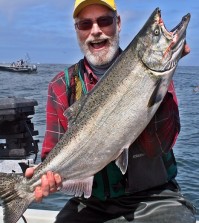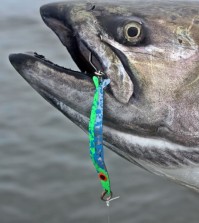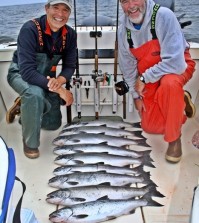Oddball Coho Tactics
The fishing and hunting exploits of Joe Wallman were legendary throughout the south end of the Olympic Peninsula and southern Puget Sound long before I made the move to Washington’s capital city in 1984, so when he started inviting me along on some of his outdoor adventures in the early nineties, I jumped at the chance. Many of Joe’s fishing tactics were unorthodox to say the least, but he seemed to always catch fish and I always learned some new tricks when we fished together.
One summer morning in 1991 Joe Wallman taught me the basics of catching Coho salmon on, well, weird stuff, for lack of a better description. Up until then I was one of the thousands of Northwest salmon anglers who believed that there were only a few ways to catch saltwater Coho, most of them involving herring in some form, but by the end of that morning I realized that the traditional fishing methods aren’t always the best ways to put salty silvers in the fish box, and I’ve been catching them on weird stuff ever since.

This shallow-running minnow imitation may not have been designed for catching salmon, but it and others like it will certainly do the job when catching is near the surface, as it often is.
We started the morning at a gravel spit near the south end of Anderson Island, where the incoming tide broke over the shallow hump and slowed a bit. Lots of what appeared to be two-inch-long baitfish were visible in the clear water, and as I rummaged through my tackle box in search of a small wobbling spoon, Joe said, “Here, give this a try first.” Into my hand he dropped a home-made leadhead jig with a body of green and yellow deer hair and a few strands of silver tinsel. The jig head was nothing more than a one-eighth-ounce split shot crimped behind the eye of a long-shank hook. I remember thinking to myself that it might catch yellow perch or crappie, but salmon?
“Don’t jig it, just cast over to the edge of the current, let it sink about three feet and reel it in,” my mentor advised. “Vary the retrieve speed a little, but don’t jig it,” he repeated.
He then cast to the edge of the current, let the jig sink three feet, started reeling, and hooked a 20-inch Coho before the lure had moved 10 feet.
Hmmmm. Maybe this jig thing wasn’t such a goofy idea after all. I netted Joe’s fish, shot a couple of pictures, and made my first cast, then a second, and a third. Half-way through my third retrieve, bam, and a second later a shiny little Coho did its Polaris missile imitation as it came flying three feet out of the water, coming unhooked in mid-air.
I was a believer, but just to seal the deal I hooked and landed a smallish Coho about 20 minutes later and Joe lost what appeared to be a very well-fed little Chinook before we decided to move to a new spot…where I would be introduced to what I then thought was an even more bizarre catching-catching strategy.
Our second stop was a shallow bay, where we glided to a stop about 100 feet from the beach. I started firing my new favorite jig toward shore and quickly discovered that the water was only a few feet deep; I hung the lure in the rocks on my second or third cast and lost it. By then Joe had tied something new to his line and had made his first cast toward several submerged boulders near the beach. I could hardly believe what I was seeing when his lure touched down and I realized it was a floating plug of some kind. He let it rest atop the water for a few seconds before beginning the retrieve, reeling steadily for about 10 feet, stopping for a few seconds, then repeating the process.
It was all I could do to keep from asking my fishing partner if he was expecting to find a largemouth bass out there somewhere, but I kept my wise-ass remarks to myself and watched as he made several more casts.
“Guess I’ll make a minor alteration,” was all he said as he pulled needle-nosed pliers from a coat pocket and broke the little plastic lip off the front of a perfectly good Rapala and resumed casting. But he used a different retrieve with the newly deformed lure, skittering it across the surface in a series of jerks and twitches, sometimes making it fly clear out of the water for a foot or two. I thought Wallman had finally lost it and was about to say so when there was a boiling surge beneath the little Rapala and two feet of silver came flying out of the water. A few minutes later I was netting another salmon and Joe was grinning from ear to ear.
Since that summer morning 20 years ago I’ve had several opportunities to use Joe Wallman’s top-water technique and variations thereof to put Coho in the fish box. I’ve never resorted to breaking parts off a lure, but I have used a variety of surface lures, including those cup-faced “popper” and “chugger” type bass lures, to catch Coho on the surface, and I’ve also caught a lot of salmon while trolling and casting diving lures designed for bass and other freshwater species. Every time I do I’m reminded that sometimes it helps to think outside the box if you want to catch those goofy fish we call silvers.
Take herring heads, for example. Most of us lop them off to produce plug-cut herring baits, and the heads are flicked into the water for the gulls and the crabs to munch on. But, as I’ve had to grudgingly concede in recent years, the heads of these little fish sometimes make as good a salmon bait as the rest of the herring. I’ve used them to catch lots of pink salmon during the past few humpy years, and during the 2010 season I caught one of my largest Westport Coho of the year on trolled herring heads fished behind a FishFlash just under the surface. Fishing buddy Harley Graves brought a 17-pound Coho to the boat on a herring-head bait during a trip to Sekiu a couple of years ago. Harley likes to fish a single head on the upper end of a tandem-hook salmon rig, but I’ve found that, well, two heads are better than one, so I’ll put one on each hook, pinning them through the tip of the snout so that they spin, roll and flash as they’re trolled through the water.
Why would any self-respecting salmon purposely inhale a herring head to which there was no herring body attached? Well, reverse the question and tell me why a salmon attacks a herring that doesn’t have a head. We alter the “natural” look of a herring every time we cut the head off one to give it that plug-cut look, so if they’ll eat a headless herring, why not a bodyless herring every now and then? It’s something to think about next time you’re an hour from the nearest marina and running low on bait.
Another odd-ball bait that might surprise you is a pink plastic worm, the kind more commonly associated with steelhead fishing. I started trolling them for pinks in 2007 (for obvious reasons), but was surprised to discover that Coho will take them, too. They have limited action of their own when trolled, so I fish them a short distance behind an 8-inch or 11-inch flasher as I would a plastic squid. I like the various Berkley PowerBait and Gulp! worms because of their built-in scent, but non-scented pink worms might work nearly as well, especially if you doused them in Smelly Jelly or some other attractant.
Soft-plastic baitfish imitations of various kinds are also finding their way into the tackle boxes of a few Northwest saltwater salmon anglers. I’ve had only limited success with them myself, but that just might be because I’ve used them only a handful of times over the past three or four years. I’ve heard, though, that a few Alaskan charter skippers are making impressive catches on baits like the 3-inch and 4-inch Gulp! Pogy. At least one of them has gone on record saying that they often out-fish fresh herring for both Coho and Chinook. Better than herring? Don’t assume he’s nuts until you try it for yourself.
It’s no secret that Coho can be flighty, unpredictable and, well, sorta goofy, so when the “normal” stuff like plug-cut herring, flasher-and-squid rigs and spinners aren’t working like they should, don’t be afraid to get creative and try something you’ve never considered before. You might be pleasantly surprised.










